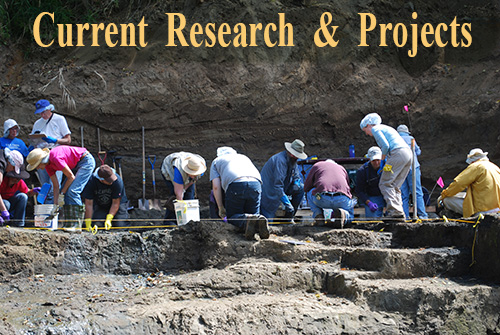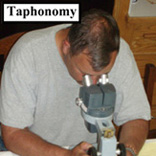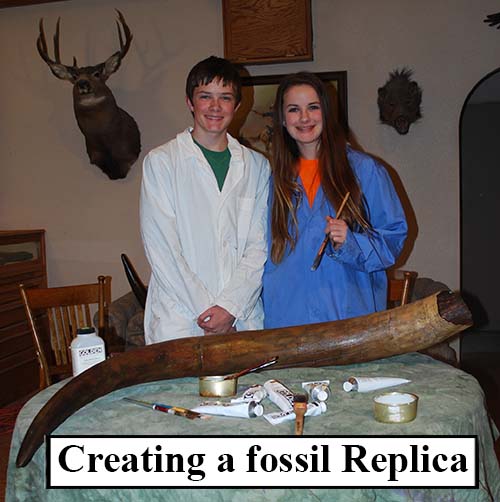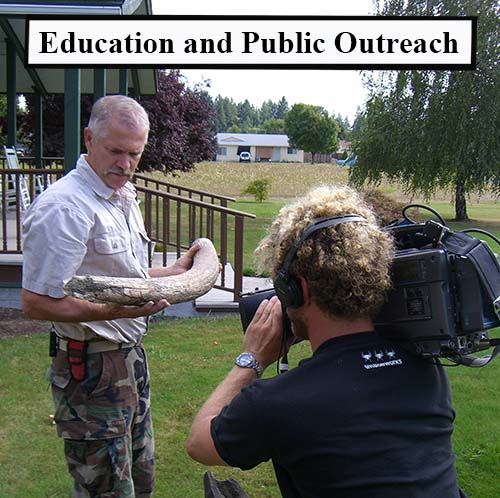Current
 Each year the Yamhill River Pleistocene Project works with land owners, local governments, volunteers and professional scientists to facilitate an annual paleo-archeological or paleontological dig during mid to late summer in our project area. We coordinate and do site preparation, access local resources and participate in the digs. Concurrently, we search for fossil and artifact locations on the Yamhill River drainage basin. The specimens found are documented, collected and preserved for further study.
Each year the Yamhill River Pleistocene Project works with land owners, local governments, volunteers and professional scientists to facilitate an annual paleo-archeological or paleontological dig during mid to late summer in our project area. We coordinate and do site preparation, access local resources and participate in the digs. Concurrently, we search for fossil and artifact locations on the Yamhill River drainage basin. The specimens found are documented, collected and preserved for further study.
When the season ends we work to stabilize and preserve specimens, update records and maps of the finds. We produce meter grids of site excavations and assist the professional scientists, when possible, in producing papers on the summer’s work, and maintain the specimen collection available to scientific investigators and the general public.
Additionally, we are committed to the public trust, and education is a large focus of our annual events. We are glad to display the fossils and artifacts to the public, and have attended elementary and high school classes as well as public service groups to deliver presentations on our Project and the late Pleistocene. We have conducted tours of our paleo-archeological dig sites, participated in job shadow training at Linfield College, and on occasion facilitated student field trips down the Yamhill Rivers.
A Multidisciplinary Approach:
We have applied a multidisciplinary approach to our project: by drawing on resources from many scientific backgrounds a more complete picture of the distant past is revealed to us. Among the scientists that have been or are actively involved in our project are paleontologists, paleo-archeologists, geologists and forensic pathologists.
Education: Presentations and Public Outreach
The Yamhill River Pleistocene Project makes a continuing effort to reach out to the community in the fields of education and public awareness. We communicate this by way of education in the classroom, presentations to groups and organizations and conducting field trips to dig sites or down the Yamhill Rivers.
Classroom presentations allow students a “hands on” experience with Pleistocene fossils and hopefully spark a future interest in science. We do our best to field requests from both public and private schools, gear our classes to the age group of the students, and leave plenty of time for questions and answers. We have worked with ages ranging from elementary school through college level.
Presentations are not limited to schools, as we have also appeared before service groups, research organizations and retirement centers. Again, we tailor our presentation to the interest area of the group and time available. These presentations not only allow us the enjoyment of sharing our adventure with others, but also gives us the opportunity to contact possible resources, help others in identifying their fossil or artifact and at times meet people who have new information for us on fossil or artifact sites.
On special occasions, we have been able to facilitate educators or students with a field trip to one of our dig sites or even a day on the river searching for fossils. Our first outing on the river with educators on board resulted in finding a small mammoth tusk embedded in a sedimentary deposit, making the memory of a lifetime for an elementary school teacher!
We have hosted classes or projects from Portland Community College, Chemeketa Community College and Linfield College at the McMinnville Site and Gilpin Site, where students excavated the site using current paleontological and paleo-archeological protocols, discovering the remains of mammoth and bison.
A trip up the South Yamhill River provided a den of Cub Scouts the opportunity to spend a day with their fathers, exploring the outdoors, watching wildlife, wading, splashing and swimming in the river, eating “military rations” for lunch, and oh yes, finding a few fossils along the way!
Inquiries for a classroom presentation, presentation to your organization or a field trip may be addressed to us through the “Contact Us” button on the main menu.
Paleontology: Excavating the fossil remains of Pleistocene mega fauna
“The study of ancient life”. Every single find is exciting, whether it is picked up along the river bank or carefully excavated from a dig site or one that can only be described as the “find of a lifetime.” While most of what we have collected has little overall significance, we have been fortunate enough to find some truly awesome specimens, such as documenting the first Bison alaskensis for Oregon, and the first Castoroides ever found west of the continental divide. Regardless of importance, all of the specimens are entered into the fossil logs, described, stabilized and maintained for continued study.
We are committed to keeping the collection together and that it remain IN the public domain. As such, all material will go one day to a museum, municipality, institution or interpretive center.
 Paleo-Archeology: Studying Pleistocene Artifacts
Paleo-Archeology: Studying Pleistocene Artifacts
Evidence of late Pleistocene/early holocene human activity is indeed quite rare in our area. To date we have not found in situ artifacts: the material we have collected has been washed from its original depositional layers and is found on point bars and the river bottom all throughout the Valley.
(The Willamette Valley Pleistocene Project has written protocols in place which will be strictly adhered to in the event that cultural material in situ or any suspected human remains are located.)
The few artifacts we have found have proven to be quite fascinating, from a variety of styles and cover a huge span of time representing possible Haskett points, Windust points, Cascade culture and recent holocene. The quest for a true Pleistocene human site has escaped us, so far, but the search continues. Dr. Alison Stenger’s Institute for Archeological Studies has taken the lead in our Paleo-Archeological studies.
 Geology and Geography: Uncovering the stratigraphy of a Pleistocene Fossil Site
Geology and Geography: Uncovering the stratigraphy of a Pleistocene Fossil Site
The geology and geography that fossils are located in give us valuable clues to what the paleo-environment was, and where to look for further finds. Much of the fossil material on the Yamhill Rivers has been redeposited. Understanding the stratigraphy lets us tell, sometimes at a glance, whether more finds from the same source are likely, and whether the fossil indicates a developing debris fan that can be traced to source. The matrix or sedimentation that the specimen was located in, its exact location and relationship to other known specimens are studied and logged.
Stratigraphy not only at the level of the specimen, but above and below it is recorded, helping us to understand how the specimen came to be where it is and what processes occurred before and after it was deposited.
 Taxonomy: Identification of fossil specimens
Taxonomy: Identification of fossil specimens
The study of each specimen found is undertaken to try to identify every species of fauna possible, and the frequency of finds may speak to the overall density and dispersal of each population. This in turn gives insight to the relationship between species and the overall environment and ecosystem.
Some bones are distinct enough to be diagnostic to the species. Teeth are an excellent example: if a complete tooth is found, the identity of the species is nearly assured. Metapodials can differentiate artiodactyls from perissodactyls at a glance. Horn cores speciate bison, and if the bone just looks strange, chances are you may have sloth.
The more successful we are at identifying as many finds as possible, the more complete our understanding. If we can not identify the fossil locally, we do not hesitate to access expert resources such as the Page Museum at the Rancho La Brea Tar Pits or the Condon Museum at the University of Oregon.
 Taphonomy: Studying a bone fragment for possible evidence of human modification
Taphonomy: Studying a bone fragment for possible evidence of human modification
The relatively new field of taphonomy, literally the study of everything that has happened to a specimen which results in it being in the condition that we have collected it in, yields exciting glances into the past. Whether examining the predatory tooth marks consistent with a dire wolf, the gnaw marks of some ubiquitous rodent, or the greenstick fracture with retouching and polishing that may indicate human modification; taphonomy can either deepen the mystery or bring a moment of pre-history into exquisite focus.
Each specimen is carefully studied to unlock its secrets. The McMinnville excavations have yielded a bison femur with exquisite gnaw marks, which when matched to the upper mandible of a grey wolf, yield compelling evidence of a dramatic moment in prehistoric time!
 Laboratory Work: Producing Museum Quality Fossil Replicas
Laboratory Work: Producing Museum Quality Fossil Replicas
Producing a museum quality fossil replica of local specimens is another opportunity to multi task education, presentations, and public awareness. We have become proficient at creating molds; then casting, preparing, detailing and painting replicas of specimens which represent the iconic prehistoric megafauna found in the Willamette Valley during the late Pleistocene. Replicas of fossils found in our local area have been produced for municipalities wishing to highlight our prehistoric past, businesses for display, educational institutions as a part of class studies, raffles to raise money for public awareness of our Pleistocene past, and as gifts to volunteers or donors.
The fossil replicas are often produced by local students and volunteers who were instrumental in finding the actual specimen, adding yet another layer of interest to the project. The finished product is nearly indistinguishable from the original, and adds to the memory of the Pleistocene adventure.


